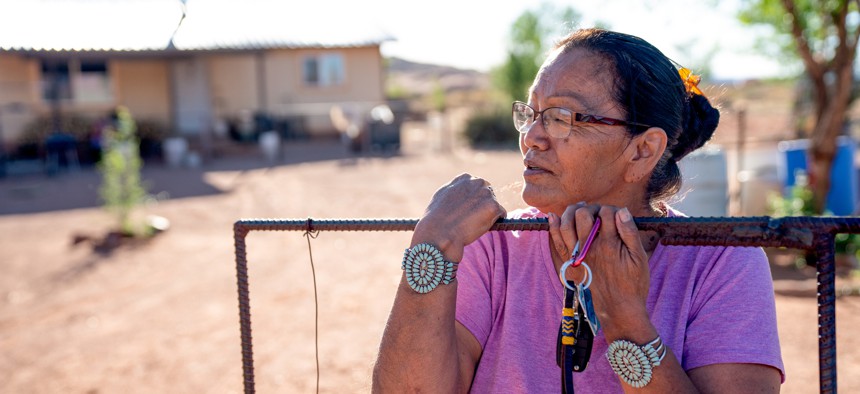How Local Governments Can Spend Their Federal Funds to Boost Equity

A Navajo woman standing by the gate of her home. istock.com/grandriver
Several county leaders and others offered suggestions for helping communities most in need using American Rescue Plan Act funds at the National Association of Counties annual conference.
Government and nonprofit officials urged county leaders to spend their American Rescue Plan Act funds with an eye toward creating equity during a Sunday session at the National Association of Counties annual conference in Maryland.
Clarence Wardell III, chief data and equitable delivery officer for the White House American Rescue Plan team, told conference attendees in person and online that local governments should design programs using the ARPA funds for communities most in need.
“Understand what people need and want; otherwise, you are not delivering services equitably,” Wardell said. “Whatever your programs are, make them work for everyone.”
James Crowder, senior associate for the nonprofit PolicyLink, outlined 10 priorities local governments should consider when allocating their ARPA funds. The recommendations suggest deploying the money strategically, and laying out a framework for equitable decision-making. Below is a full list of the priorities Crowder walked through.
- Explicitly name racial equity as a goal with a specific target to produce results at scale.
- Engage with historically underserved populations.
- Connect unemployed and low-wage workers with good jobs and career opportunities.
- Stabilize and grow businesses owned by people of color and immigrants.
- Restore and expand public services that deliver critical infrastructure to disadvantaged communities.
- Invest in frontline, Covid-impacted and disadvantaged communities.
- Prevent displacement and increase community ownership of land and housing.
- Strengthen civic infrastructure that builds the power and capacity of marginalized communities.
- Prioritize a few deep cross-sector, high-impact equity investments.
- Track disaggregated data to ensure accountability to equity goals.
PolicyLink’s "10 Priorities for Advancing Racial Equity Through the American Rescue Plan: A Guide for City and County Policymakers" was developed in partnership with community leaders, chief equity officers, policymakers, economic development practitioners, research and policy organizations and philanthropic partners.
“Who benefits? Who pays? Who decides,” Crowder said. “These are the three critical guiding questions for equity.”
Also during the session, John Wilson, assessor for King County, Washington, which includes Seattle, said his county is employing “14 determinants of equity” for spending its $440 million in ARPA funds.
Meanwhile, Janae Ladet and Sasha Legette, two officials from Harris County, Texas, which includes Houston, said the county is employing its equity framework for how to spend its APRA funding. They said each project will have to pass three independent assessments in order to receive the federal funds. Harris County and Houston are expected to receive more than $1.5 billion combined in federal aid.
Finally, Ken Wilson, county administrator for Franklin County, Ohio, which includes Columbus, said that his government created action steps in 2019 for moving toward equity in all programs and projects, and that the county is seeking to spend its ARPA funds with an eye toward those objectives.
But he said: “These investments must go beyond ARPA.”
Jean Dimeo is the managing editor for Route Fifty.
NEXT STORY: The Hemp Boom is Over. What Now?





